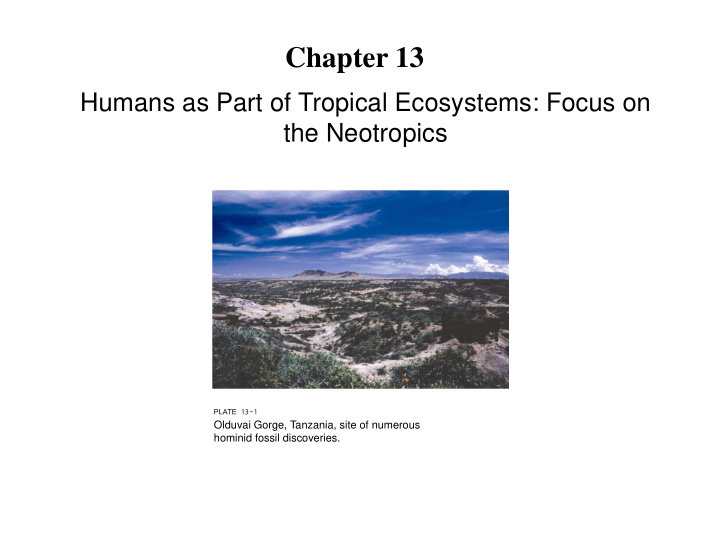



Chapter 13 Humans as Part of Tropical Ecosystems: Focus on the Neotropics PLATE 13-1 Olduvai Gorge, Tanzania, site of numerous hominid fossil discoveries.
FIGURE 13-1 Combined, the molecular, genetic, and archeological records from Siberia, Beringia, and North and South America suggest that humans dispersed from southern Siberia shortly after the last glacial maximum (LGM), arriving in the Americas as the Canadian ice sheets receded and the Pacific coastal corridor opened, 15,000 years ago.
FIGURE 13-2 Anthropogenic modification of “virgin” tropical rain forest. The map indicates the three largest undisturbed rain forest blocks remaining worldwide. These are located in the Amazon Basin, the Congo Basin, and Southeast Asia (Indo- Malay region). Evidence is accumulating from archeological and paleoecological studies that each of these regions was disturbed by prehistoric human settlements but subsequently regenerated once the populations moved on or died out. This suggests that given sufficient time, tropical rain forests disturbed by modern human activities may be able to regenerate.
PLATE 13-2 ANGKOR WAT
FIGURE 13-3 Satellite image [Landsat 4 Thematic Mapper, path 225, row 69; 21 June 1992; bands were assigned as 5(red)–4(green)–3(blue)] with global positioning system–mapped Ipatse cluster sites X6 and X13 (a, insets) linked by the north–south road and transit-mapped X11 (b, inset). Ditches are colored in red; road and plaza curbs are black. Fieldwork in 2003 demonstrated that roads extend fully from X13 to X18 and continue on to X19, X20, and beyond along the north–south road, as well as across high ground to X17 and X22; X11 roads also connect it to the four satellites. MTFX, Mato Grosso (the state), Formadores do Xingu (the archeological region). The number refers to the site number. FIGURE 13-4 (a) Map of Brazil showing major vegetative regions and areas of Amazonian complex societies, including (1) Mato Grosso state outlined; (2) blue-green forest in eastern Brazil is open broad-leaf associated with the Atlantic forest biome. (b) Proposed cluster distributions in the Upper Xingu Basin. White circles are based on the presence of major (. 30 hectares) walled centers; red unnumbered circles are hypothetical. Area of acute anthropogenic influence is denoted by an orange circle (150 kilometers diameter, ,17,500 kilometers square) and moderate to minimal anthropogenic influence by a red circle (250 kilometers diameter, ,50,000 kilometers square).
PLATE 13-3 Terra preta soil (very dark) at the surface of this cut.
PLATE 13-4 Temple 2 at Tikal dates to the Mayan Classic period, when much of the surrounding forest was cleared for intensive agriculture.
PLATE 13-5 Palms in the genus Bactris are widely utilized by indigenous peoples in the Neotropics.
PLATE 13-6 CLOVIS POINTS
PLATE 13-7 Yanomami people remain essentially a hunter–gatherer society.
PLATE 13-8 Gray-winged trumpeter, a bird often sought by Amazonian indigenous people.
PLATE 13-9 FIGURE 13-5 This plot of cleared land, called a milpa, is planted A scenario for the evolution of food production from mostly with corn. It is typical of rotational agriculture in plants. southern Belize (in this case) as well as much of the rest of the tropics.
PLATE 13-10 FIGURE 13-6 Water buffalo are used for labor and food in This diagram illustrates H. T. Odum’s concept of the many tropical areas. energetics of simple agriculture (in this case, in India). The arrow-shaped boxes with an X inside are called multipliers because they enhance the productivity of the land. Typical multipliers are abiotic factors such as rain and biotic factors such as the use of farm animals for labor, as well as a feedback loop involving human labor tending crops. Note that the system is sufficiently productive to allow some export.
PLATE 13-11 Fields of rice characterize much of the landscape of Bali, Indonesia, where rice has been successfully farmed for hundreds of generations.
PLATE 13-12 The charred remains of trees are readily visible among the bananas growing on this slash-and- burn agricultural plot on Trinidad.
PLATE 13-13 Small farms such as this one commonly practice swidden- type agriculture.
PLATE 13-14 Young mestizo boy skillfully paddling a dugout canoe. PLATE 13-15 Coffee beans ripening on the plant. PLATE 13-16 Cacao fruits grow from cauliflorous flowers on understory trees.
FIGURE 13-7 Bird effects on (a) all and (b) large (.5 millimeters) arthropods as a factor of migrant bird diversity. Each point represents bird data for only omnivorous and insectivorous birds that primarily forage in the strata in which bird exclosures were placed. Correlations were determined using linear regressions, with the percentage reduction of all or large arthropods as the dependent variable and species diversity as the independent variable.
(a) (b) PLATE 13-18 (a) This is the same area in Belize some years later, when some of the canopy trees were removed to permit more sunlight for coffee growth. The dense coffee understory is readily evident. (b) Added light enhances the productivity of the coffee crop but reduces the ecosystem’s overall biodiversity. PLATE 13-17 This coffee plantation near Gallon Jug, in western Belize, is representative of a rustic coffee approach. There is a dense canopy of indigenous trees. The biodiversity of this plantation is high.
PLATE 13-19 Cassava crop in Indonesia. Cassava is native to the Neotropics but has been planted throughout the tropical world.
PLATE 13-20 CURARE VINE AND LEAVES
PLATE 13-21 COCA LEAVES
Recommend
More recommend